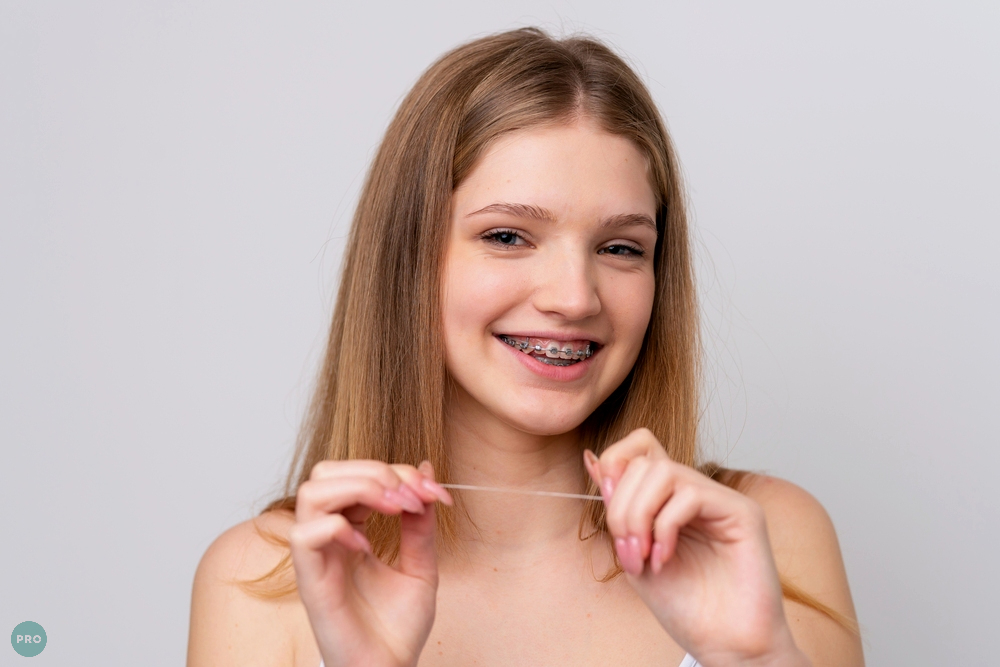Do you need help figuring out how to floss with braces in Manassas, VA? Flossing with braces can feel challenging, but it’s one of the most important steps in keeping your teeth and gums healthy during orthodontic treatment. This guide from Potomac River Orthodontics explains why flossing matters, which tools make it easier, and how to do it correctly. Keep reading to learn how to make flossing with braces simple.

Why Flossing with Braces Is Important
Braces straighten teeth, but they also create small spaces where plaque and food particles can hide. These spots are hard to clean with just brushing. If not removed, the plaque can lead to cavities, tartar buildup, and even gum disease. Adding flossing to your daily oral hygiene routine ensures your teeth and gums stay healthy. It also makes your orthodontic treatment more effective and keeps your smile on track.
Tools That Make Flossing with Braces Easier
Using the right tools can make flossing faster and less frustrating. Let’s look at some great options:
1. Floss Threaders
Floss threaders act like small needles that guide floss under the archwire of your braces. These tools make reaching between teeth easier without harming your brackets or wires. Threaders are beginner-friendly and a must-have for anyone flossing with braces.
2. Water Flossers
Water flossers, also called water picks or irrigators, spray a thin stream of water to clean food particles and plaque from hard-to-reach spots. They’re gentle on gums and ideal for cleaning around brackets and wires effectively.
3. Superfloss
Superfloss is a pre-cut floss with stiff ends designed to slide easily under archwires. It also has soft, spongy sections to clean plaque from the gumline. Superfloss is perfect for people who need more precision when flossing and keep the gum health.
4. Interdental Brushes
These tiny brushes, also called proxabrushes, fit into the narrow spaces between teeth and braces. They help remove food debris and plaque where traditional floss may struggle to reach.
5. Floss Picks
Floss picks have a small strand of floss attached to a handle. They make flossing faster and simpler, especially for patients who are short on time or have limited hand dexterity.
How to Get Flossing Tools
You can find floss tools like threaders, water flossers, and proxabrushes at most pharmacies, online retailers, or dental stores. Many orthodontic offices, including Potomac River Orthodontics in Manassas, VA, provide flossing kits to help you maintain your oral hygiene routine.
Steps to Floss with Braces
Flossing with braces may feel tricky at first, but with practice, it gets easier. Follow these simple steps for a more effective cleaning routine:
Step 1: Prepare Your Floss
Cut about 18 inches of dental floss. Use a floss threader to guide the floss under the wire if you’re using standard floss. Position the floss around the base of a tooth to clean it thoroughly.
Step 2: Clean Around Each Tooth
Wrap the floss in a “C” shape around one tooth. Gently move the floss up and down along the tooth surface and below the gumline. Be careful not to pull too hard or damage your gums or brackets.
Step 3: Try a Water Flosser
A water flosser can make your routine faster and more effective, especially in hard-to-reach areas. Direct the stream around brackets, wires, and gums to remove debris and plaque buildup.
Step 4: Finish with Brushing
After flossing, brush your teeth using a soft-bristle toothbrush and fluoride toothpaste. Clean all tooth surfaces, including around the brackets and wires. Brushing for at least two minutes ensures thorough cleaning. Finally, rinse with a fluoride mouthwash to protect against plaque and cavities.
Tailored Flossing Techniques for Different Braces
Different types of braces may require slight adjustments to your flossing routine:
- Metal Braces: Thread the floss carefully under the wires and clean between brackets.
- Clear Braces: Be extra gentle when cleaning around the brackets to avoid damaging the clear materials.
- Lingual Braces: Since these braces are behind the teeth, use a water flosser or interdental brush to reach tough spots.
- Self-Ligating Braces: Although these braces have fewer components, paying attention to wires and under brackets is still necessary.
Common Challenges and Solutions
Flossing with braces can feel overwhelming at first, but these tips will help:
Problem: Sensitive Gums
Solution: Rinse with warm salt water to ease irritation. Over time, regular flossing strengthens your gums, making them healthier and less sensitive. Be gentle when flossing to avoid extra soreness. If the pain lasts for many days, ask your orthodontist for advice.
Problem: Hard-to-Reach Areas
Solution: Use tools like water flossers or proxabrushes to clean tricky areas, such as back teeth or under archwires. Move slowly to make sure you reach all spots without hurting your gums. These tools can help remove food and plaque that normal floss might miss.
Problem: Time-Consuming Routine
Solution: Flossing with braces may take longer in the beginning, but tools like floss picks or superfloss can simplify the process. Consistency is key to better results. As Dr. Shalise Holt, a professional orthodontist in Twinsburg, OH, advises, using tools like floss picks or water flossers can significantly reduce the time it takes to floss while maintaining effectiveness.
Caring for Your Teeth After Braces
Once your braces are removed, maintaining a healthy oral hygiene routine is key to keeping your smile beautiful.
- Clean Your Retainer: Wash your retainer daily to prevent plaque buildup.
- Floss Daily: Continue to floss every night to avoid plaque and tartar buildup.
- Brush Thoroughly: Use a fluoride toothpaste to brush twice a day, keeping your enamel strong and your teeth healthy.

Expert Advice from Potomac River Orthodontics
At Potomac River Orthodontics in Manassas, VA, we believe that excellent oral hygiene is essential during orthodontic treatment. Flossing every day helps protect your teeth from cavities, tartar, and gum disease. Here’s how we support our patients:
- Personalized Instructions: We teach you flossing techniques specific to your type of braces.
- Recommended Products: Our team suggests tools like floss threaders, platypus flossers, and water picks to simplify cleaning.
- Preventive Care: We provide tips to reduce plaque buildup, protect your gumline, and improve your flossing routine.
Keep Your Smile Healthy
At Potomac River Orthodontics in Manassas, VA, we make flossing with braces simple and stress-free. Whether you’re new to braces or improving your daily routine, we’ll help you maintain a clean, confident smile every step of the way. Schedule your visit today and discover how easy it can be to care for your braces with expert support.
About The Authors
Dr. Owais Naeem – Orthodontist in Manassas, VA
Dr. Shalise Holt – Orthodontist in Twinsburg, OH
Frequently Asked Questions
Is it okay to skip one day of flossing with braces?
It’s best to floss every day, but missing one day isn’t a big deal. Life gets busy, and sometimes we forget. That’s okay! Just try not to make it a habit. Get back to your routine the next day to keep your teeth and gums healthy. Regular flossing helps prevent cavities and keeps your smile clean while you have braces.
Is it normal to not be able to floss with braces?
Yes, it’s totally normal to have a hard time flossing with braces. Those wires and brackets make it tricky to reach between your teeth. Many people struggle with it at first, so you’re not alone! The good news is there are tools that can help, like floss threaders, water flossers, and tiny brushes. With some patience and practice, it’ll get easier.
How to floss with braces without a threader?
You can still floss with braces. Cut about 18 inches of floss and tie the ends to make a small loop. Use your fingers to guide the loop between your teeth and gently move it up and down. It takes a bit of practice, but it works well. You can also use a water flosser or small interdental brushes for easier cleaning.



